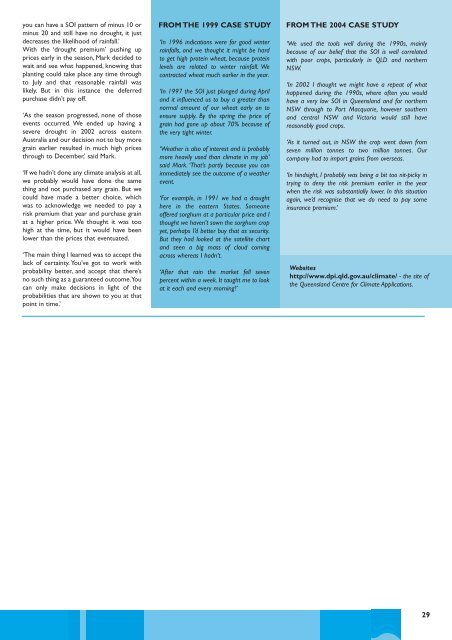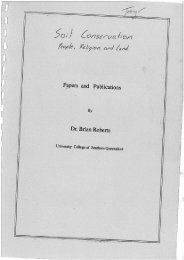Masters of the Climate: Innovative farmers ... - South West NRM
Masters of the Climate: Innovative farmers ... - South West NRM
Masters of the Climate: Innovative farmers ... - South West NRM
Create successful ePaper yourself
Turn your PDF publications into a flip-book with our unique Google optimized e-Paper software.
you can have a SOI pattern <strong>of</strong> minus 10 or<br />
minus 20 and still have no drought, it just<br />
decreases <strong>the</strong> likelihood <strong>of</strong> rainfall.’<br />
With <strong>the</strong> ‘drought premium’ pushing up<br />
prices early in <strong>the</strong> season, Mark decided to<br />
wait and see what happened, knowing that<br />
planting could take place any time through<br />
to July and that reasonable rainfall was<br />
likely. But in this instance <strong>the</strong> deferred<br />
purchase didn’t pay <strong>of</strong>f.<br />
‘As <strong>the</strong> season progressed, none <strong>of</strong> those<br />
events occurred. We ended up having a<br />
severe drought in 2002 across eastern<br />
Australia and our decision not to buy more<br />
grain earlier resulted in much high prices<br />
through to December,’ said Mark.<br />
‘If we hadn’t done any climate analysis at all,<br />
we probably would have done <strong>the</strong> same<br />
thing and not purchased any grain. But we<br />
could have made a better choice, which<br />
was to acknowledge we needed to pay a<br />
risk premium that year and purchase grain<br />
at a higher price. We thought it was too<br />
high at <strong>the</strong> time, but it would have been<br />
lower than <strong>the</strong> prices that eventuated.<br />
‘The main thing I learned was to accept <strong>the</strong><br />
lack <strong>of</strong> certainty. You’ve got to work with<br />
probability better, and accept that <strong>the</strong>re’s<br />
no such thing as a guaranteed outcome.You<br />
can only make decisions in light <strong>of</strong> <strong>the</strong><br />
probabilities that are shown to you at that<br />
point in time.’<br />
FROM THE 1999 CASE STUDY<br />
‘In 1996 indications were for good winter<br />
rainfalls, and we thought it might be hard<br />
to get high protein wheat, because protein<br />
levels are related to winter rainfall. We<br />
contracted wheat much earlier in <strong>the</strong> year.<br />
‘In 1997 <strong>the</strong> SOI just plunged during April<br />
and it influenced us to buy a greater than<br />
normal amount <strong>of</strong> our wheat early on to<br />
ensure supply. By <strong>the</strong> spring <strong>the</strong> price <strong>of</strong><br />
grain had gone up about 70% because <strong>of</strong><br />
<strong>the</strong> very tight winter.<br />
‘Wea<strong>the</strong>r is also <strong>of</strong> interest and is probably<br />
more heavily used than climate in my job’<br />
said Mark. ‘That’s partly because you can<br />
immediately see <strong>the</strong> outcome <strong>of</strong> a wea<strong>the</strong>r<br />
event.<br />
‘For example, in 1991 we had a drought<br />
here in <strong>the</strong> eastern States. Someone<br />
<strong>of</strong>fered sorghum at a particular price and I<br />
thought we haven’t sown <strong>the</strong> sorghum crop<br />
yet, perhaps I’d better buy that as security.<br />
But <strong>the</strong>y had looked at <strong>the</strong> satellite chart<br />
and seen a big mass <strong>of</strong> cloud coming<br />
across whereas I hadn’t.<br />
‘After that rain <strong>the</strong> market fell seven<br />
percent within a week. It taught me to look<br />
at it each and every morning!’<br />
FROM THE 2004 CASE STUDY<br />
‘We used <strong>the</strong> tools well during <strong>the</strong> 1990s, mainly<br />
because <strong>of</strong> our belief that <strong>the</strong> SOI is well correlated<br />
with poor crops, particularly in QLD and nor<strong>the</strong>rn<br />
NSW.<br />
‘In 2002 I thought we might have a repeat <strong>of</strong> what<br />
happened during <strong>the</strong> 1990s, where <strong>of</strong>ten you would<br />
have a very low SOI in Queensland and far nor<strong>the</strong>rn<br />
NSW through to Port Macquarie, however sou<strong>the</strong>rn<br />
and central NSW and Victoria would still have<br />
reasonably good crops.<br />
‘As it turned out, in NSW <strong>the</strong> crop went down from<br />
seven million tonnes to two million tonnes. Our<br />
company had to import grains from overseas.<br />
‘In hindsight, I probably was being a bit too nit-picky in<br />
trying to deny <strong>the</strong> risk premium earlier in <strong>the</strong> year<br />
when <strong>the</strong> risk was substantially lower. In this situation<br />
again, we’d recognise that we do need to pay some<br />
insurance premium.’<br />
Websites<br />
http://www.dpi.qld.gov.au/climate/ - <strong>the</strong> site <strong>of</strong><br />
<strong>the</strong> Queensland Centre for <strong>Climate</strong> Applications.<br />
29
















